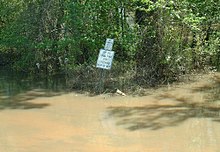Ochlockonee River
| Ochlockonee River | |
|---|---|
NWFWMD | |
| Physical characteristics | |
| Source | |
| • location | Gordy, Georgia |
| • coordinates | 31°29′06″N 83°52′49″W / 31.48500°N 83.88028°W |
Ochlockonee Bay | |
• location | Surf, Florida |
• coordinates | 29°58′36″N 84°26′15″W / 29.97667°N 84.43750°W |
| Length | 206 mi (332 km) |
| Basin size | 2,450 sq mi (6,300 km2) |
| Discharge | |
| • location | Bloxham |
| • average | 1,796 cu ft/s (50.9 m3/s) |
| Basin features | |
| Tributaries | |
| • left | Little River, Telogia Creek, Crooked River |
The Ochlockonee River ( /oʊˈklɒknɪ/ o-KLOK-nee) is a fast running river, except where it has been dammed to form Lake Talquin in Florida, originating in Georgia and flowing for 206 miles (332 km)[1] before terminating in Florida.
Background
The name is from the
The river forms the western boundaries of
History

When the Spanish arrived in northern Florida, the Ochlockonee River formed the western boundary of their Apalachee Province. Late 17th-century Spanish documents refer to the river as Claraquachine[a] and Amarillo (Spanish for "yellow"). A 1716 Spanish document called it Rio de Lagna (lagna is probably Apalachee for "yellow"). An English map from 1720 identifies it as the Yellow River. A 1778 map spells the river's name "Okalockney", while one from 1856 has it as "Oklokonee". The modern name probably derives from the Hitchiti/Mikasuki Oki (water) and Lagana (yellow).[5]
From 1839 to 1842, Fort Virginia Braden was established on the river located at Fort Braden in Florida. The fort was named after the commander's wife who died of yellow fever.
The Civil War
The Ochlockonee River saw action during the
Jackson Bluff Dam

In 1927 the Jackson Bluff Dam was constructed on the Ochlockonee River to produce hydroelectric power. The waters held back by the dam formed Lake Talquin.
Importance

The Ochlockonee River corridor is home to many threatened fish, wildlife and plant species. It has been designated under the State of Florida's
Rare animals that can be found along the Ochlockonee include red-cockaded woodpecker, least tern, and the Apalachicola dusky salamander.[7] The river is especially rich in rare freshwater mussels (Unionidae), including three federally listed endangered species: the Ochlockonee moccasinshell, the Shinyrayed pocketbook, and the Oval pigtoe.[8] "The Florida maybell tree can be found only along the Ochlockonee and Chipola Rivers.[7]
The Ochlockonee is connected to and a source of water for Lake Iamonia, especially during flooding.
Recreation
Fishing for
The Ochlockonee is a vital link in the production of
Crossings
A number of major highways cross the Ochlockonee River along its course, including
See also
- South Atlantic-Gulf Water Resource Region
Notes
- ^ The name may have been Apalachee or Chatot (both were Muskogean languages). The Chine (as in Claraquachine) people, who moved into Apalachee Province during the 17th century, may have been a branch of the Chatot.
References
- ISBN 978-0-9606708-1-9.
- ISBN 0-915430-00-2.
- ^ "Ochlockonee River State Park". Retrieved 2007-01-11.
- ISBN 978-1-56164-400-1
- ^ Simpson, J. Clarence (1956). Florida Place-Names of Indian Derivation. Tallahassee, Florida: Florida Geological Survey. pp. 77–78.
- ^ "Frank Howard". The Ochlockonee River. Retrieved 2007-01-11.
- ^ a b c d e "1000 Friends of Florida". The Ochlockonee River. Archived from the original on February 6, 2012. Retrieved 2007-01-11.
- ^ Hemming, Jon M. et al., 2006, Water and sediment quality at mussel (Unionidae) habitats in the Ochlockonee River of Florida and Georgia. Endangered Species Research 2: 37-49.






